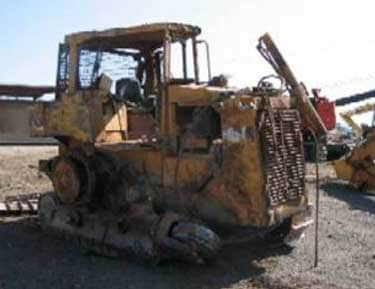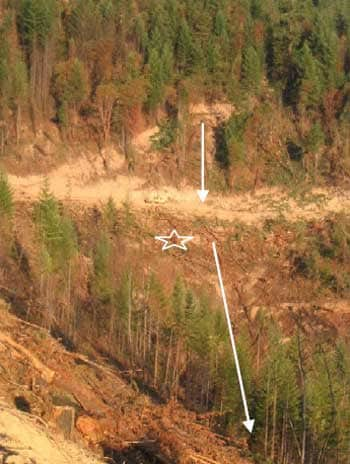Operator Killed When Bulldozer Slides Off Logging Road
Oregon Case Report: 03-OR-029-01
Summary
On September 6, 2003, a 75-year-old logger, working as a bulldozer operator, was killed when the D6H Caterpillar crawler tractor he was operating tumbled off a steep skid road into a ravine. The operator was climbing a 20-25 degree slope while reopening an old skid road. The bulldozer slid off of the road against a tree while on a hard rock face covered by a 4-inch surface of scrabble rock. The operator apparently regained control, and may have been trying to get the bulldozer back up on the road when it slipped off the 60-70 degree sidehill and tumbled about 150 ft to a logging road, where the operator was ejected. The bulldozer bounced another 450 ft into a ravine. The event was not witnessed. Fatal injuries probably occurred when the victim was thrown around in the cab, before being ejected.
 |
|
The D6H Caterpillar following the incident shows noticeable damage – missing the front blade, rear grapple, and tracks – but the operator’s cage is relatively intact.
|
Recommendations:
- Develop a site-specific safety plan that includes an assessment of hazards and plans to minimize the risks.
- When operating off-road work machines, wear the seatbelt, or utilize some other form of personal safety restraint.
- Seek assistance when needed.
- Drop the blade to help control or stop a slide.
- Manufacturers should evaluate operator restraint systems for mobile equipment to design improvements that facilitate use of seatbelts and harnesses.
Introduction
On September 6, 2003, a 75-year-old logger, working as a bulldozer operator, was killed when the D6H Caterpillar crawler tractor he was operating tumbled off a steep skid road into a ravine. OR-FACE was notified of the incident on September 8. An OR-FACE investigator conducted an onsite visit with the employer the next day. This report is based on the OR-FACE investigation, and reports from Oregon OSHA, the county sheriff, and medical examiner.
The logging firm had been in business for approximately 60 years. The current management operated the business for the past 16 years, and employed three full crews, about 20 workers, down from a peak workforce of 120 in earlier years. Six workers were in the area at the time of the incident.
The employer had a written safety program and held weekly safety meetings with all of the crews. In addition, a logging safety consultant regularly visited all sites, unannounced, and observed employees while working. The consultant met with individuals in one-on-one sessions and in full work teams to discuss safety performance.
The bulldozer operator was a partner in the original business and had since retired, but helped out from time to time. With over 50 years of experience, he was a longstanding member of the local logging community and very knowledgeable in all aspects of logging. He was skilled in operating all kinds of logging machinery, and trained the current employer. This special relationship prevented the employer from enforcing certain safety standards that applied to other employees, such as wearing a seat belt while operating the bulldozer.
Investigation
The logging firm was working on private land in a salvage operation. A large forest fire burned the area in 2002, and the operator had been harvesting dead, burned standing timber in the unit for more than a year. The unit was properly designated as an active logging area, but the old, disused roads needed to be improved before beginning logging operations. Even with improvements, the roads were only “minimal,” according to the employer. The terrain ranged from gradual 15-20 degree slopes to very steep.
On the day of the incident the bulldozer operator was working to reopen a pre-existing skid road. The road was cut into the hillside, rising at a 20-25 degree slope from the main logging road toward the top of the unit. The operator had taken the bulldozer down the road a few days before and was familiar with the road’s general layout.
About 150 ft up the road, a hard layer of sedimentary rock was exposed. The bulldozer’s metal tracks lost traction on the slick rock surface, and the 27-ton machine slid off the road, but was stopped by an old madrone tree. The bulldozer was facing uphill at this point. The operator had probably dropped the blade in an attempt to stop the slide off the road, causing the machine to face uphill when it came to rest against the tree. The operator regained control and apparently decided to turn downhill to get off the side of the mountain.
The exact maneuver at this point is not clear, but in the effort to regain the road, the bulldozer slipped off the steep 60-70 degree sidehill and tumbled several times before hitting the main logging road 150 ft below. The impact tore off the blade and the operator was ejected. The bulldozer continued to tumble to the bottom of the ravine another 450 ft farther, leaving a trail of metal debris.
The victim was found sitting up, supported by a stump about 50 ft below the main road. He was pronounced dead at the scene. It is believed the victim died from injuries received while being thrown around inside the cab.

|
|
Arrows indicate the path of the Caterpillar as it tumbled off the skid road into the ravine. The star shows where the operator was thrown from the cab.
|
Cause of Death
Multiple traumatic injuries.
Recommendations/Discussion
Recommendation #1: Develop a site-specific safety plan that includes an assessment of hazards and plans to minimize the risks.
Before starting logging operations and site development, a work plan should be developed beforehand that includes a survey of site hazards. The survey should evaluate all potential work areas for hazards, and specify procedures to eliminate or minimize risks. The plan needs to be conveyed to all employees working at the site at a pre-work safety meeting.
Recommendation #2. When operating off-road work machines, wear the seatbelt, or utilize some other form of personal safety restraint.
The victim in this incident is reported to have rarely worn personal restraints while operating heavy equipment. The employer acknowledged this was a risky work practice, but also believed the personal restraints were not designed to meet the demands of the working conditions where the bulldozer was being used. Employees operating heavy equipment with this employer have complained about using personal restraint systems, because they are often bruised or injured by them, even in less demanding circumstances.
In the development of the OSHA standard requiring the provision and use of seatbelts in mobile logging machinery (29 CFR 1910.266 (d)(3)), consideration was given to received comments regarding undue restriction and increased hazard on steep terrain. Reviewing the evidence of machine rollovers, however, showed that all victims were thrown from the cab and crushed by the machine, which might have been avoided by providing and wearing a seatbelt. OSHA considered, but decided not to allow any exceptions to the seatbelt rule. Due to evidence that many operators wear the seatbelt loosely, and that this does not protect the operator in a rollover, OSHA also requires the seatbelt to be securely fastened.
Recommendation #3. Seek assistance when needed.
The operator in this incident could have sought assistance when he first slid off of the road. Even an experienced operator should be willing to acknowledge hazardous circumstances and solicit help and advice from coworkers.
Recommendation #4. Drop the blade to help control or stop a slide.
When faced with a situation where the bulldozer starts to slide, it is best to drop the blade in an attempt to stop the downward progression. Usually dropping the blade is enough to stop sideways motion, though in some circumstances the blade may slide on the hard surface as well. On steep terrain, wherever possible, a bulldozer should face downhill while working to increase the effectiveness of the blade to control a slide.
Recommendation # 5. Manufacturers should evaluate operator restraint systems for mobile equipment to design improvements that facilitate use of seatbelts and harnesses.
To encourage operators to wear a seatbelt, better design and different options need to be made available to improve usability. Even in simple circumstances, mobile equipment operators must continually move around in the seat for visibility. Worker dissatisfaction with the present design of occupant restraints in heavy equipment leads to noncompliance and management enforcement issues. Improved seatbelt designs that keep operators restrained within the cab in the event of a rollover or tipover, while at the same time providing them with comfort and maximum mobility within the cab are needed (see OSHA 1996 for further discussion of this issue).
References
- National Institute for Occupational Safety and Health. (2004). Preventing injuries when working with ride-on roller/compactors [Pub 2005-101]. Available online: https://www.cdc.gov/niosh/docs/wp-solutions/2005-101/pdfs/2005-101.pdfpdf icon
- Occupational Safety & Health Administration. (1996). Logging operations: Paragraph (d) General requirements: Seat belts [29 CFR 1910.266]. Available online: https://www.osha.gov/SLTC/etools/logging/mechanical/machines.htmlexternal icon (Link updated 3/26/2013)
- West Virginia Fatality Assessment and Control Evaluation. (2003). Logging site heavy equipment operator dies after being pinned by the dozer he was operating in West Virginia [03WV022-01]. Available online: https://www.cdc.gov/niosh/face/stateface/wv/03wv022.html
Oregon FACE Program
CROET at OHSU performs OR-FACE investigations through a cooperative agreement with the National Institute for Occupational Safety and Health (NIOSH), Division of Safety Research. The goal of these evaluations is to prevent fatal work injuries in the future by studying the work environment, the worker, the task, the tools, the fatal energy exchange, and the role of management in controlling how these factors interact.
To contact Oregon State FACE program personnel regarding State-based FACE reports, please use information listed on the Contact Sheet on the NIOSH FACE web site. Please contact In-house FACE program personnel regarding In-house FACE reports and to gain assistance when State-FACE program personnel cannot be reached.
Oregon FACE reports are for information, research, or occupational injury control only. Safety and health practices may have changed since the investigation was conducted and the report was completed. Persons needing regulatory compliance information should consult the appropriate regulatory agency.

